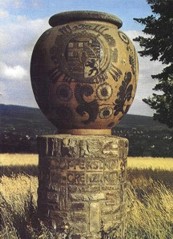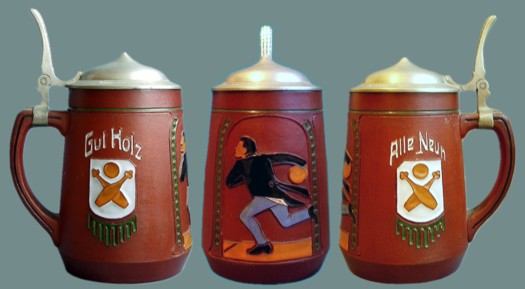
 Stein Collectors International
Stein Collectors International
Featured Stein: March 2005

 Stein Collectors International
Stein Collectors International
Featured Stein: March 2005
|
by Ronald E. Gray
This Dümler and Breiden stein features a bowling scene. Quick now, how many pins went down with that strike, nine or ten? If you said ten, you are not living in the past. Back in the late 19th century, particularly in Germany, it was a game of nine pins. As a matter of fact, that was the game Rip Van Winkle saw the ghosts of Henry Hudson's crew playing before his twenty-year nap. The inset lids of Mettlach bowling steins usually feature the layout of nine pins in the shape of a baseball diamond (see example, below right). The early Germans used to carry a pin, called a Kegel, for defensive purposes. The monks used it in nine pin as the head-pin target and encouraged the parishioners to knock down the devil. That is how we got the words kegler and kegling. Some eBay listings call these scenes skittle, but that is the English game and these are definitely German steins and the German game. We started out playing nine pins in the United States too, but betting on the sport caused the nine pin game to be declared illegal. Luckily, they also had lawyers back then and one supposedly came up with a loophole to the law by just adding one pin. And that was how we got today's ten pin game. Golf steins lead the sports-themed steins as far as premium pricing goes, thanks to well-heeled golfers (they will buy anything golf related). Sports Illustrated ran an article on a golf-related stein collection in their November 8, 1954 issue (that was pre-swimsuit issues, but it still did not make the cover). Bowling steins, on the other hand, are one of the least expensive of the sports-themed steins. Bowling is a bare-bones sport; you can rent the shoes and the ball, and the other equipment is provided by the bowling alley. I couldn't even find a bowling song for this article, but you will have to keep guessing why I selected the song I did or keep reading the article. While bowlers are well known beer drinkers, walk into any bowling alley and you will see bowlers knocking them down faster than the pins can fall. They prefer their beer straight out of the can or bottle. Nevertheless, the International Bowling Museum and Hall of Fame in St. Louis, Missouri (across from Busch Stadium) features some Mettlach steins in their display. I know about bowling as I joined a bowling league right after I graduated
from high school. I once had a 226 in the first game. Unfortunately, I was
unable to achieve even a 400 series as the celebration started too early. Since
the statute of limitations has expired, I can confess that we used to skip high
school every Thursday afternoon in my senior year to go bowling for ten cents a
line at Rainbow Lanes in Fremont, Ohio. I also was an early casualty of
technology, having been replaced as a pin setter by the automatic pin setting
machines that were introduced in the 1950s. When the Dutch brought the game to
New York, they used to play it outdoors and the area became known as Bowling
Green. Did I mention that I graduated from Bowling Green State University in
Ohio? The more reasons you can find to collect steins, the easier it is to
collect them.
As the boys grew older, both wanted to become potters, a main occupation in
Höhr due to the rich deposit of clay in the Westerwald area (for more information on Westerwald stoneware
visit the Library section of
this site and read the articles A Westerwald History or The
Kannenbäckerland). Albert learned the trade from his uncle, Simon Peter
Gerz, learning the techniques on how to run a pottery. Peter got his training
from both Reinhold Hanke and Simon Peter Gerz, preferring to use his artistic
talents for the design of pottery. Peter took pride in his ability to imitate
work from the 16th century and hid his initials, "PD," in the
intricate designs (as noted by David Gaimster in his book German Stoneware
1200-1900). They started their firm on a shoestring in 1883, when both were
in their early 20s, to produce practical crockery for the home. They quickly
obtained recognition by winning first prize in exhibits in both Antwerp and
Koblenz in 1885. Around 1890 they started producing steins. Their partnership
went beyond the business though. Albert married Peter's sister and the two
families shared the same large double house that also served as the office for
the adjoining factory. |
|||||||||||||||
 |
|||||||||||||||
|
  Since Chicago hosted the World's Columbian Exposition of 1893, I suspect the
2.1 meter stein, which was free turned by hand, might have been displayed in the
brewery exhibit. My search on the Internet was not successful, but if anyone in
Chicago has access to a more thorough listing of photographs from the
exposition, they may have more success. I did find a site that has some photos
from the exposition and it did show some interesting photos of the brewery
exhibit. I asked Chicago's Museum of Science and Industry to
search their archives for the 1893 Exposition to see if they could find a photo
or information on this 2.1 meter stein. Unfortunately their search was
unsuccessful. Perhaps a search of the Chicago newspapers from 1893 would be more
fruitful. There had to be some publicity for such a large and expensive stein. I
still think it would have been displayed at the 1893 Exposition. With the death of Peter in 1907, Albert took over managing the firm along with Peter's widow. Production of Jugendstil steins began around this time. While Paul Dümler, Peter's son, designed the terra sigillata steins, Albert no doubt had a say in selecting terra sigillata, a very smooth, lustrous coating of clay which resembles a glaze, usually red and virtually waterproof. According to The Encyclopedia Britannica, the Latin term literally means wares made of clay impressed with designs, while another source translates it as sealed earth. Perhaps his choice of material was influenced by the fact that Albert, his daughter Paula and his father share a common trait - they all had red hair. I furnished a photo of this stein to a ceramic instructor to get his comments. He had not encountered it before and thought it was an interesting piece. He opined that it appeared to be just a refined clay slip without being polished. The Roman terra sigillata wares have a high gloss finish because the terra sigillata is polished to help seal the pottery. Albert retired from the firm in 1913, but had to help run the company during World War I. When his sons returned from the war (Peter's son Paul died in World War I), Albert had to take over the management of his uncle's firm, Simon Peter Gerz I. The inflation of the 1920s virtually wiped Albert out. In a letter to his daughter Paula, he stated he could not even afford a beer. Herr Breiden died in 1926 at the age of 65. The firm of Dümler and Breiden, however, survived until sometime after its 100th anniversary in 1983. This stein has three scenes: the front shows a bowler approaching the line
while the side panels have a banner with two crossed pins and a bowling ball
above them. One side scene says Gut Holz (good wood) and the other says Alle
Neun (all nine, or strike). 
The inside of the stein has a greenish or turquoise glaze. Iron in the material could cause the glaze to be a soft green, but that copper or chrome was probably used for this rich green color. The lid is inscribed Unserem lieben "Tupp" gewidmet vom Kegelklub "Fröhliche Gesichter," which roughly translates to "Our dear "Tupp" dedicated from the Kegel Club "happy faces." The mark on the bottom of the stein is one of the two marks you will find on their terra sigillata steins. The other mark is a plain "T" with the "S" intertwined with the "T." Although I could not find a specific reference to the use of these two marks, I believe they were specifically designed for the terra sigillata steins. If anyone has either of these two marks on a stein other than terra sigillata, please let us know. The other Dümler and Breiden marks are shown below. Like last month's Rosskopf & Gerz stein, this one is also marked on the bottom with "ges. geschutzt," which means registered design, on two lines. In this instance, however, it is in lower case letters rather than upper case letters. The mold number of this stein is 1290. My recent review of 295 stein auction catalogs, approximately 115,000 steins, revealed only 31 listings of Dümler and Breiden terra sigillata steins. Two molds had multiple listings and five listings did not identify a mold number. The mold numbers included 116, 838, 953, 972, 980 (four listings), 1033, 1181 (11 listings), 1202, 1215, 1284, 1384, 1524 and 1614. Earlier catalogs included some steins that appeared to be Dümler and Breiden terra sigillata steins, but the mark may not have been known at the time to identify them as such and I could not verify that the steins were terra sigillata due to the photos being black and white. The book in reference 3 lists an additional four molds: 939, 981, 1032 and 1103. These 19 or so terra sigillata steins would make a nice display. I am not aware of any other manufacturer of this era that made terra sigillata steins. It is not so unusual to find so few of these steins however, since this is a more difficult material with which to work. |
|||||||||||||||
References:
|
|||||||||||||||